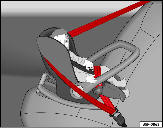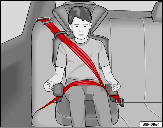
Seat Ibiza: Child seats
Seat Ibiza Owners Manual
Categorisation of child seats into groups
Use only child seats that are officially approved and suitable for the child.
Child seats are subject to the regulation ECE-R 44. ECE-R means: Economic Commission for Europe Regulation
The child seats are grouped into 5 categories:
Group 0:
Children up to 10 kg
Group 0+:
Children up to 13 kg
Group 1:
from 9 to 18 kg
Group 2:
from 15 to 25 kg
Group 3:
from 22 to 36 kg
Child seats that have been tested and approved under the ECE R 44 standard bear the test mark on the seat (the letter E in a circle with the test number below it).
Group 0 and 0+ child seats
A suitable child seat and a correctly adjusted seat belt can help to protect your child.

Fig. 27 A group 0 rearfacing child seat fitted on the rear seat.
Group 0:
For babies from about 9 months old and 10 kg in weight the most suitable seats are those appearing in the illustration ⇒ fig. 27. Group 0+:
For babies from about 18 months old and 13 kg in weight the most suitable seats are those appearing in the illustration ⇒ fig. 27. Follow the manufacturer's instructions and observe any statutory requirements when installing and using child seats. We recommend that you include the manufacturer's directions for child seat use in the vehicle wallet and always keep them in the vehicle.
WARNING
Read and always observe information and warnings concerning the use of child
seats ⇒  in “Safety notes on using
in “Safety notes on using
child seats” on page 43.
Group 1 child seats
A suitable child seat and a correctly adjusted seat belt can help to protect your child.

Fig. 28 A category 1 forward-facing child seat fitted on the rear seat.
Child seats using the “ISOFIX” and “Toptether” system (or even the anti-rotation system) or seats in which the child faces the rear of the car are most appropriate for babies and small children weighing between 9 and 18 kg. Follow the manufacturer's instructions and observe any statutory requirements when installing and using child seats. We recommend that you include the manufacturer's directions for child seat use in the vehicle wallet and always keep them in the vehicle.
WARNING
Read and always observe information and warnings concerning the use of child
seats ⇒  in “Safety notes on using
in “Safety notes on using
child seats” on page 43.
Group 2 and 3 child seats
A suitable child seat and a correctly adjusted seat belt can help to protect your child.

Fig. 29 Forward-facing child seat installed on rear seat.
Follow the manufacturer's instructions and observe any statutory requirements when installing and using child seats. We recommend that you include the manufacturer's directions for child seat use in the vehicle wallet and always keep them in the vehicle.
Group 2 child seats
Children under 7 years of age weighing between 15 and 25 kg are best protected by group 2 child seats in conjunction with properly adjusted seat belts.
Group 3 child seats
Children over 7 years of age weighing between 22 and 36 kg but less than 1.5 metres tall are best protected by seat cushions with head restraints in conjunction with properly worn seat belts ⇒ fig. 29
WARNING
• The shoulder part of the seat belt must lie approximately on the centre of the shoulder, never across the neck or the arm. The seat belt must lie close to the torso. The lap belt part must lie across the pelvis, not across the stomach, and always fit closely. Pull the belt tight if necessary to take up any slack, “Seat belts”.
• Read and always observe information and warnings concerning the use of child
seats ⇒  in “Safety notes on using
in “Safety notes on using
child seats” on page 43.
Other info:
Renault Clio. Display B
Vehicles fitted with touch-screen
multimedia, navigation aid systems,
telephones, etc.
Refer to the separate instructions for
the function to understand the special
features of this equipme ...
Mazda 2. Emergency Operation for Starting the Engine
If the KEY warning light (red) illuminates,
or the push button start indicator light
(amber) fl ashes, this could indicate that
the engine may not start using the usual
starting method. Have your ...
Skoda Fabia. Engine compartment
WARNING
When working in the engine compartment, injuries, scalding, accident
or
fire hazards may arise. For this reason, it is essential to comply with the
warning instructions stated below and w ...
Manuals For Car Models
-
 Chevrolet Sonic
Chevrolet Sonic -
 Citroen C3
Citroen C3 -
 Fiat Punto
Fiat Punto -
 Honda Fit
Honda Fit -
 Mazda 2
Mazda 2 -
 Nissan Micra
Nissan Micra -
 Peugeot 208
Peugeot 208 -
 Renault Clio
Renault Clio -
 Seat Ibiza
Seat Ibiza -
 Skoda Fabia
Skoda Fabia - Honda Pilot
- Volkswagen ID4
- Toyota Prius


